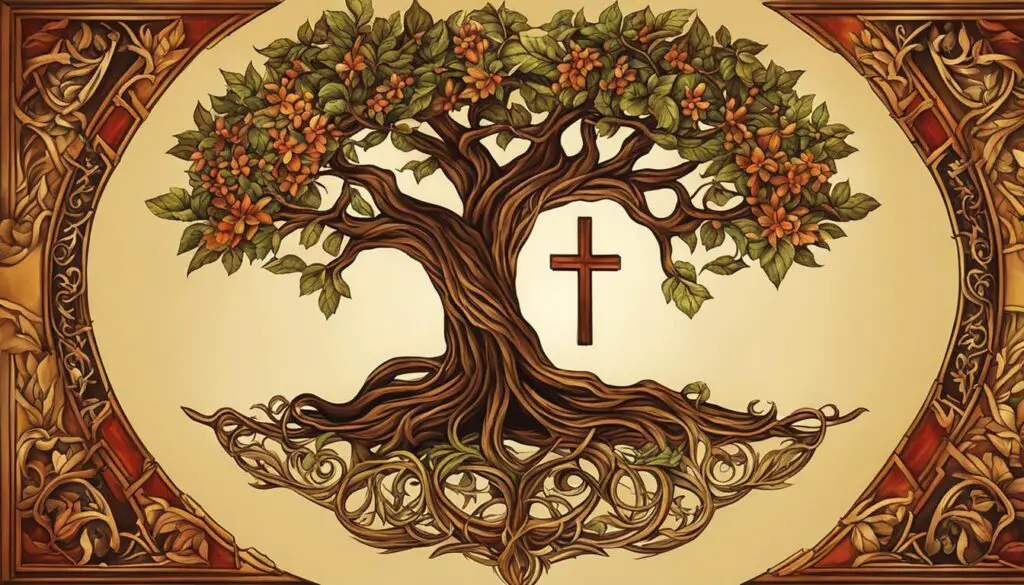Throughout the pages of the Bible, trees hold a deep spiritual significance, symbolizing profound truths and offering valuable lessons to believers. From the creation story to the life and teachings of Jesus Christ, biblical trees reflect God’s wisdom, creativity, and provision. Understanding the symbolic meaning of trees in the Bible enhances our understanding of God’s plan for humanity and encourages our spiritual growth.
Key Takeaways
- The symbolism of trees in the Bible runs deep, representing spiritual truths and providing valuable lessons.
- From the first mention of a tree in the book of Genesis to Jesus’ teachings about trees, biblical trees reflect God’s wisdom and provision.
- The Tree of Life and the Tree of the Knowledge of Good and Evil in the Garden of Eden exemplify the importance of obedience and the consequences of sin.
- Jesus often used trees in His parables to convey essential teachings about faith, spiritual fruitfulness, and dependence on Him.
- The cross, often referred to as the “tree,” symbolizes the sacrifice of Jesus Christ and the hope of salvation for believers.
The Creation and Symbolism of Trees
One of the earliest mentions of trees in the Bible can be found in the book of Genesis, highlighting their significance in biblical narratives. In the creation account, God spoke trees into existence, showcasing His wisdom, creativity, and provision. Trees symbolize life, growth, and fertility, reflecting God’s abundant blessings upon creation.
The symbolism of trees becomes even more evident in the story of Adam and Eve in the garden of Eden. The trees present in the garden hold deep spiritual meaning. The Tree of Life represented eternal communion with God, while the Tree of the Knowledge of Good and Evil was a test of obedience. These trees serve as reminders of the importance of choices, the consequences of sin, and humanity’s need for redemption.
The Tree of Life and the Tree of the Knowledge of Good and Evil
Two significant trees featured in the Garden of Eden were the Tree of Life and the Tree of the Knowledge of Good and Evil. These trees hold deep symbolic meanings and provide valuable insights into the human condition and our relationship with God.
The Tree of Life represented eternal communion with God and the promise of immortality. It stood as a testament to God’s abundant provision and the intimate fellowship enjoyed between God and Adam and Eve. Its significance extended beyond physical life to encompass spiritual life, offering a pathway to eternal union with the Creator.
“And out of the ground the Lord God made to spring up every tree that is pleasant to the sight and good for food. The tree of life was in the midst of the garden, and the tree of the knowledge of good and evil.”
On the other hand, the Tree of the Knowledge of Good and Evil presented a choice between obedience and disobedience. God commanded Adam and Eve not to eat from this tree, for in doing so, they would gain knowledge of good and evil, but also experience the consequences of sin. It represented the boundary between God’s perfect will and the potential for human rebellion.
The presence of these two trees in Eden highlights the importance of obedience, the consequences of sin, and humanity’s need for redemption. Their symbolism provides profound insights into the fallen state of humanity and the redemptive work of Jesus Christ, who became the ultimate sacrifice on a tree to restore humanity’s access to eternal life and communion with God.
| Tree | Symbolism |
|---|---|
| Tree of Life | Eternal communion with God |
| Tree of the Knowledge of Good and Evil | Choice, obedience, consequences of sin |
Trees in the Life of Jesus
Jesus, the central figure of Christianity, often used trees and nature to convey profound spiritual truths. Through his teachings and interactions, he highlighted the significance of trees and their symbolic meaning in the lives of believers. Jesus employed various tree-related metaphors and parables to emphasize important lessons about faith, growth, and discipleship.
Mustard Seed: One of the most famous tree-related teachings of Jesus is the parable of the mustard seed. In this parable, Jesus compares the Kingdom of Heaven to a tiny mustard seed that grows into a large tree. This metaphor highlights the power of faith and its potential for significant growth. It encourages believers to have faith in God’s promises and trust in His transformative work in their lives.
“If you have faith as small as a mustard seed, you can say to this mountain, ‘Move from here to there,’ and it will move. Nothing will be impossible for you.” – Matthew 17:20
Fruitful Fig Tree: Jesus also used the fig tree as a symbol of spiritual fruitfulness. In one instance, he curses a barren fig tree, demonstrating the importance of genuine discipleship and the need for spiritual fruit in the lives of believers. This teaching emphasizes the significance of bearing good fruit through a vibrant relationship with God.
“A good tree cannot bear bad fruit, and a bad tree cannot bear good fruit.” – Matthew 7:18
The Cross: Perhaps the most profound tree symbolism in Christianity is the cross, on which Jesus was crucified. The cross represents God’s love and redemption for humanity. It serves as a powerful reminder of the sacrificial love of Jesus and the hope of eternal life for believers. The image of Jesus’ crucifixion on a wooden cross makes the tree an enduring symbol of faith and salvation.

Trees and Jesus’ Teachings
Jesus’ teachings about trees offer valuable insights into the spiritual life of believers. They encourage individuals to have faith, bear fruit, and embrace the redemptive work of God. By understanding the symbolism behind trees in Jesus’ teachings, believers can deepen their spiritual journey and grow in their relationship with God.
- Have faith like a mustard seed, believing in God’s transformative power.
- Bear good fruit through genuine discipleship and a vibrant relationship with God.
- Recognize the sacrificial love and redemption offered through Jesus’ crucifixion on the cross.
By applying these teachings in their lives, believers can experience spiritual growth, bear fruit in their character and actions, and find hope and salvation in Jesus Christ.
Trees in Parables and Teachings
Jesus often utilized the imagery of trees in His parables to convey important spiritual teachings. These parables provide valuable insights into concepts such as spiritual fruitfulness and remaining connected to Jesus, the true vine. By exploring these parables, believers can gain a deeper understanding of their faith and how to live a fruitful life in Christ.
The Parable of the Sower and the Seeds
In the parable of the sower and the seeds, Jesus compares the Word of God to seeds that are sown on different types of soil. One of the soil types mentioned is “good soil,” which represents a receptive heart that hears and understands the Word of God, resulting in spiritual fruitfulness. Just as a tree needs fertile soil to grow and bear fruit, believers need to cultivate a heart that is open to God’s Word and receptive to His teachings. This parable highlights the importance of nurturing our hearts and minds to receive and apply God’s truth in our lives.
The Parable of the Vine and Branches
In the parable of the vine and branches, Jesus compares Himself to a vine, and believers are depicted as branches. He emphasizes the importance of remaining connected to Him to produce spiritual fruit. Just as a branch cannot bear fruit unless it remains attached to the vine, believers can only bear spiritual fruit when they remain connected to Jesus, drawing nourishment and strength from Him. This parable underscores the vital role of our relationship with Jesus in living a fruitful and fulfilling Christian life.
Lessons from the Parables
These parables about trees teach us important lessons about spiritual fruitfulness and remaining connected to Jesus. They remind us that faith must be nurtured and cultivated in our hearts, just as a tree needs fertile soil to grow. They also emphasize the significance of our relationship with Jesus and the importance of staying connected to Him through prayer, studying His Word, and abiding in His love.
In summary, Jesus used the imagery of trees in His parables to convey timeless spiritual truths. The parables of the sower and the seeds and the vine and branches highlight the importance of a receptive heart and remaining connected to Jesus for spiritual fruitfulness. Through these teachings, believers are encouraged to cultivate their faith, nurture their relationship with Jesus, and bear abundant fruit in their lives.
The Symbolism of the Cross in Christianity
The cross holds profound significance in Christianity, representing the ultimate sacrifice of Jesus Christ for the salvation, forgiveness, and reconciliation of humanity with God. As a symbol of a tree, the cross embodies the intersection of divine grace and human redemption. Just as a tree provides shelter, sustenance, and life, the cross offers hope, healing, and eternal life to believers.
The importance of the cross can be traced back to the crucifixion of Jesus on a wooden cross. This act of sacrifice is often referred to as the “tree,” symbolizing God’s immense love for humanity. Through Jesus’ death on the cross, believers find forgiveness for their sins and the opportunity to have a restored relationship with God.
“For the message of the cross is foolishness to those who are perishing, but to us who are being saved it is the power of God.”
The cross serves as a powerful reminder of God’s love and the hope of eternal life. It calls believers to embrace the transformative power of the cross in their lives, surrendering their own desires and taking up their cross to follow Jesus. In doing so, believers are reminded of the sacrificial love and grace poured out for them on the cross, inspiring them to live lives marked by love, compassion, and selflessness.

The Significance of the Cross in Christianity
The cross holds deep significance in Christian theology and practice. It represents the central event that defines the faith and serves as a constant reminder of God’s redemptive plan for humanity. The cross embodies the ultimate sacrifice and serves as a focal point for worship and meditation.
| Symbolism | Meaning |
|---|---|
| Salvation | The cross represents the means by which believers can receive salvation and eternal life through faith in Jesus Christ. |
| Forgiveness | The cross symbolizes God’s forgiveness and the opportunity for believers to receive forgiveness for their sins. |
| Reconciliation | Through the sacrifice of Jesus on the cross, believers are reconciled with God and can experience a restored relationship with Him. |
| Love | The cross is a visual representation of God’s immense love for humanity. It serves as a reminder of the selfless and sacrificial nature of love. |
| Hope | The cross offers hope to believers, assuring them of the promise of eternal life and the victory over sin and death through Jesus’ resurrection. |
Trees in Specific Bible Verses
The Bible contains numerous references to trees, highlighting their significance in various cultural and historical contexts. These mentions provide valuable insights into the symbolic and spiritual meanings associated with trees. Let’s explore a few specific verses that mention trees in the Old and New Testaments:
1. Psalms 1:3 (NIV)
“That person is like a tree planted by streams of water, which yields its fruit in season and whose leaf does not wither—whatever they do prospers.”
This verse portrays the blessedness of a person who delights in God’s law and seeks to follow His ways. The imagery of a tree planted by streams of water signifies the believer’s continuous nourishment and spiritual growth. It emphasizes the importance of staying rooted in God’s word and maintaining a close relationship with Him, resulting in a fruitful and prosperous life.
2. Revelation 22:2 (NIV)
“On each side of the river stood the tree of life, bearing twelve crops of fruit, yielding its fruit every month. And the leaves of the tree are for the healing of the nations.”
In the book of Revelation, the tree of life is mentioned as a symbol of eternal communion with God. The abundance of fruit reflects the everlasting provision and sustenance found in His presence. Furthermore, the healing properties of the tree’s leaves signify the restoration and wholeness that God brings to the nations through His redemptive work.
3. Mark 8:24 (NIV)
“…I see people; they look like trees walking around.”
In this passage, Jesus heals a blind man, and initially, the man sees people who appear as trees. This unique occurrence demonstrates the gradual progression of the man’s sight. Beyond its literal meaning, this verse serves as a reminder of how Jesus brings spiritual enlightenment and understanding to our lives, gradually unveiling the depths of His truth and transforming our perception.
The Bible comprises numerous other verses that mention trees, each offering its own unique insight and symbolism. These references remind us of the intricate relationship between nature and spirituality, and how God weaves profound truths into the fabric of creation.
| Verse | Description |
|---|---|
| Psalms 1:3 | Portrays the blessedness of a person rooted in God’s word |
| Revelation 22:2 | Symbolizes eternal communion with God and His provision |
| Mark 8:24 | Illustrates Jesus’ gradual revelation of spiritual understanding |
Trees for Construction and Altars
Trees in the Bible not only hold symbolic significance but also had practical uses in biblical times. Wood from trees was used for construction, providing materials for buildings, furniture, and even altars. The use of trees in construction showcases their importance and presence in biblical narratives, serving as a testament to their practical value.
Throughout the Old and New Testaments, trees are referenced in the context of construction projects. For example, in 1 Kings 6:15, the construction of Solomon’s temple mentions the extensive use of cedar wood, known for its durability and beauty. Trees were also used to build altars, which were central to worship practices in ancient times. The altars represented a place of divine encounter and were often constructed using wood from specific trees, such as acacia wood, which was highly regarded for its strength and resistance to decay.
“The LORD said to Moses: ‘Speak to the Israelites and get twelve staffs from them, one from the leader of each of their ancestral tribes. Write the name of each man on his staff. On the staff of Levi write Aaron’s name, for there must be one staff for the head of each ancestral tribe. Place them in the tent of meeting in front of the ark of the covenant law, where I meet with you. The staff belonging to the man I choose will sprout, and I will rid myself of this constant grumbling against you by the Israelites.'” – Numbers 17:1-5
The use of trees in constructing altars and other structures reflects the practicality and resourcefulness of ancient cultures. It also demonstrates how nature and faith intertwined in the biblical narrative, with trees serving as tangible elements connecting believers to the divine. By understanding the use of trees in construction and altars, we gain a deeper appreciation for their role in biblical history and the cultural context in which they were utilized.
| Tree | Use |
|---|---|
| Cedar | Used for the construction of Solomon’s temple |
| Acacia | Used for building durable and long-lasting altars |
| Olive | Used for making oil used in religious ceremonies |
| Palm | Used for constructing booths during the Feast of Tabernacles |
Trees in Cultural and Historical Context
Understanding the significance of trees in ancient times provides valuable insights into their symbolism in the Bible. In many ancient cultures, trees were revered for their strength, stability, and connection to life. They were often regarded as manifestations of the divine, representing fertility, abundance, and spiritual nourishment. Trees held a central place in religious rituals and were considered sacred in various societies.
For example, in ancient Mesopotamia, the Tree of Life was a common motif found in artwork and mythology, symbolizing immortality and the connection between heaven and earth. The Egyptians, too, held trees in high regard, associating them with the goddess Hathor, who was believed to grant blessings and protect against evil spirits. Similarly, in Greek mythology, the nymphs, known as Dryads, were believed to dwell within trees, embodying their essence and guarding their sanctity.
“The sacred tree is to be respected. It is not to be damaged or cut down for any reason, except for a specific religious ceremony or with the permission of the gods.”
– Ancient Egyptian Proverb
The cultural and historical context of trees provides a rich foundation for understanding their symbolic significance in the Bible. By recognizing these ancient beliefs and practices, we can gain a deeper appreciation for the profound spiritual teachings associated with biblical trees.
| Culture | Significance of Trees |
|---|---|
| Mesopotamia | Symbolized immortality and the connection between heaven and earth |
| Egypt | Associated with the goddess Hathor and believed to grant blessings and protection |
| Greek | Believed that nymphs dwelled within trees, guarding their sanctity |
Spiritual Lessons from Biblical Trees
Biblical trees offer profound insights and teachings that can deeply impact our faith and spiritual journey. Through their symbolism and stories, we can learn valuable lessons about faith, growth, and the transformative power of God’s love. By applying these insights from trees to our own lives, we can strengthen our relationship with God, bear spiritual fruit, and find solace in His grace and mercy.
“Just as a tree needs strong roots to grow and withstand the storms, our faith requires a solid foundation in God’s Word and His promises. By grounding ourselves in His truth, we can grow spiritually and stand firm in the face of challenges.” – John 15:5
One of the key lessons we can learn from trees is the importance of growth and fruitfulness. Just as a healthy tree produces abundant fruit, we are called to bear spiritual fruit in our lives. This means living out the virtues of love, joy, peace, patience, kindness, goodness, faithfulness, gentleness, and self-control. By allowing God to work in us and through us, we can impact the world around us and bring glory to His name.
Additionally, trees remind us of the power of surrender and trust. Just as a tree bends and sways in the wind, we are called to surrender our plans and trust in God’s perfect will. Through the challenges and trials we face, we can find strength and resilience by relying on God’s wisdom and guidance. Like a tree drawing nourishment from the soil, we draw our strength and sustenance from God, finding rest and peace in His presence.
The Importance of Trees in Biblical Symbolism
Biblical trees hold significant symbolism throughout the Scriptures, representing various aspects of our faith and relationship with God. For example, the Tree of Life in the Garden of Eden represents eternal communion with God and the abundance of His presence. The Tree of the Knowledge of Good and Evil, on the other hand, serves as a reminder of the consequences of disobedience and the need for redemption through Christ.
As we reflect on the lessons from these symbolic trees, we are invited to deepen our understanding of God’s love, grace, and redemptive work in our lives. Just as trees bear witness to the seasons of growth, change, and renewal, our faith journey is a constant process of transformation and renewal in Christ.
| Lesson | Scripture Reference |
|---|---|
| Growth and Fruitfulness | John 15:5 |
| The Power of Surrender | Proverbs 3:5-6 |
| Abiding in God’s Presence | Psalm 1:1-3 |
| The Parable of the Mustard Seed | Matthew 13:31-32 |
| The Parable of the Vine and Branches | John 15:1-8 |
As we delve deeper into the spiritual lessons from biblical trees, we are encouraged to apply these insights to our faith journey. By nurturing our spiritual roots, cultivating spiritual fruit, surrendering to God’s plans, and abiding in His presence, we can grow in faith and experience the fullness of life in Christ.

Conclusion
Trees and spirituality are intricately intertwined in the Bible, holding profound significance and offering timeless lessons for believers. Through their symbolism and representation, biblical trees convey God’s wisdom, provision, and redemptive work throughout history.
From the beginning of creation to the life and teachings of Jesus Christ, trees serve as powerful metaphors for spiritual truths. They remind us of God’s creative power, his blessings upon creation, and the importance of obedience and faith.
The lasting impact of biblical trees resonates with believers today, inspiring us to deepen our relationship with God, bear fruit in our lives, and find solace in his grace and mercy. Reflecting on the profound symbolism of trees in the Bible invites us to embark on a spiritual journey of growth and transformation, guided by the wisdom and love of our heavenly Father.
FAQ
What is the significance of trees in the Bible?
Trees in the Bible hold profound spiritual symbolism, representing God’s wisdom, provision, and redemptive work.
Where is the first mention of a tree in the Bible?
The first mention of a tree is found in the book of Genesis, symbolizing God’s wisdom, creativity, and provision.
What do the Tree of Life and the Tree of the Knowledge of Good and Evil symbolize?
The Tree of Life represents eternal communion with God, while the Tree of the Knowledge of Good and Evil symbolizes the choice between obedience and disobedience.
How did Jesus use trees in His teachings?
Jesus often used trees and nature to convey spiritual truths, emphasizing faith, growth, fruitfulness, and the transformative power of God’s love.
What does the cross symbolize in Christianity?
The cross symbolizes the sacrifice of Jesus Christ for salvation, forgiveness, and reconciliation with God, representing the intersection of divine grace and human redemption.
Are there specific trees mentioned in the Bible?
Yes, various trees such as the cedars of Lebanon, the fig tree, and the olive tree are mentioned in the Bible, providing cultural and historical context.
What practical uses did trees have in biblical times?
Wood from trees was used for construction purposes, providing materials for buildings, furniture, and altars.
How does understanding the cultural and historical context deepen our appreciation for biblical trees?
Examining the cultural and historical context helps us comprehend the layered meanings associated with biblical trees, including their symbolic significance in ancient societies.
What spiritual lessons can we learn from biblical trees?
Biblical trees teach us about faith, growth, fruitfulness, and the transformative power of God’s love, encouraging believers to deepen their relationship with God and find meaning in their spiritual journey.







